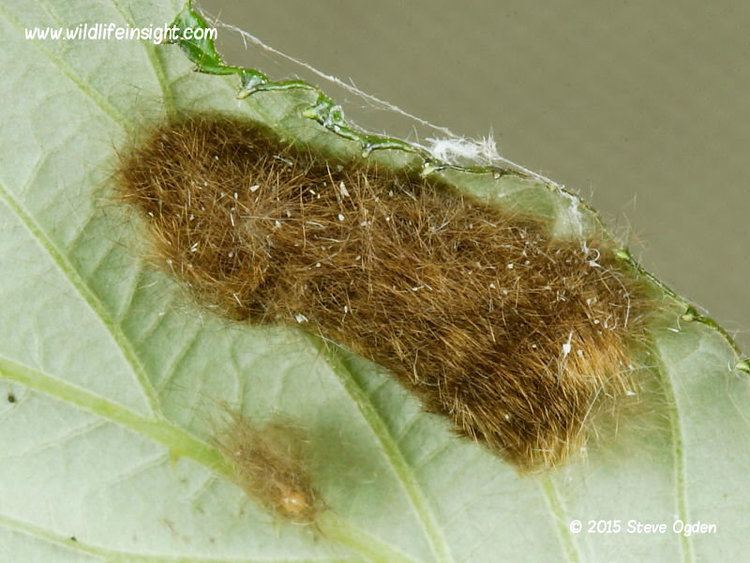Kingdom Animalia Subfamily Lymantriinae Scientific name Euproctis chrysorrhoea Higher classification Euproctis Order Butterflies and moths | Family Erebidae Genus Euproctis Phylum Arthropoda Rank Species | |
 | ||
Similar Euproctis, Insect, Butterflies and moths, Lymantriinae, Lymantria dispar | ||
Brown tail moth caterpillar on the move
The brown-tail (Euproctis chrysorrhoea) is a moth of the family Lymantriidae. It is distributed throughout Europe. It is found in North America only on the coast of Maine and Cape Cod where it is considered an invasive species that arrived in the USA in the 1890s on nursery stock coming from Europe. This univoltine defoliator feeds on 26 genera of non-resinous trees and shrubs belonging to 13 different families. Considering that it is unusual for an insect to feed on members belonging to more than two different families,[1] the polyphagy of this pest is remarkable. Brown-tail moth polyphagy, together with its tendency to reach outbreak densities, makes this species a major pest of hardwood forests; it may also attack fruit and ornamental trees.[2]
Contents

Description

The wings of this species are pure white, as is the body, apart from a tuft of brown hairs at the end of the abdomen. The brown coloration extends along most of the back of the abdomen in the male. In the female, the back of the abdomen is white, but the tuft of brown hairs is much bigger. The wingspan is 36–42 millimetres (1.4–1.7 in). The species flies at night and is attracted to light.

The larva is brown with red and white markings and is very hairy. These hairs provide protection for this species throughout its life cycle: the larva incorporates some into the cocoon within which it pupates; the emerging adult female collects some on its tail and uses it to camouflage and protect the eggs as they are laid. The species overwinters communally as larvae within a tough, silken tent. In areas where the species is abundant, these tents are a familiar sight, and can be seen on a huge range of plants (see list below).
Life cycle

The peculiarity of brown-tail moth's life history is that for 10 months of a year it is in the larval stage, overwintering as young larvae. The phenology of this pest may be summarized as follows:[3][4][5]

- Pre-diapausing larvae: they emerge and feed gregariously in August after about three weeks of egg incubation.
- Diapausing larvae: as a response to shortened periods of daylight,[6] larvae build communal winter nests in the fall, inside of which they overwinter.
- Post-diapausing gregarious larvae: they resume feeding in early April synchronized with bud break and still inhabit the winter nest as their resting place.
- Post-diapausing dispersive larvae: once larvae reach late instars, colonies break up and larvae start feeding independently. Larvae pupate in June after six to eight instars.[7] Imagos appear about one month later; they do not feed, have a short lifespan, and lay their eggs in late July and early August.
The factors underlying brown-tail moth population dynamics are little understood and have been only thoroughly investigated by few researchers.[8][9][10][11][12][13][14] They found that parasitoids, microsporidial disease and intraspecific competition were the most important mortality agents. In North America, the incidence of parasitism is the most important factor dictating the persistence of the exotic populations exclusively in coastal habitats.[15] Knowledge concerning the role of plant factors is limited to larval performance and development on different host plants. With regard to weather factors, it is known that diapausing larvae are cold tolerant but susceptible to freezing by extreme cold.[16][17] In North America, besides parasitism, cold temperatures may prevent the browntail moth from extending its invasive range from coastal to inland habitats. Intraspecific competition may also be implicated in brown-tail moth mortality, since in several populations survival was higher at low densities. During outbreaks browntail moth females show an increased fecundity.
Effect on humans
Cicely Blair wrote a paper about the rash caused by the brown-tail moth caterpillar in 1979. It was found that the loose hairs break off as barbs and on contact with skin can cause rashes, skin irritation, headaches and breathing difficulties. The species should be handled using protective gloves at all stages of its life cycle.
